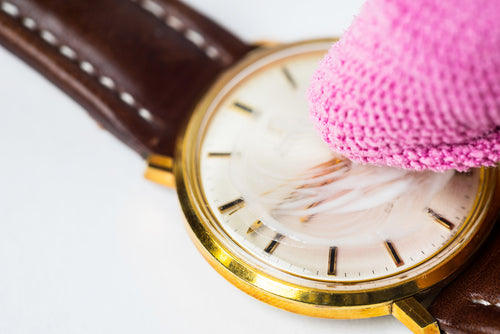Polishing a watch crystal is a simple yet effective way to restore its shine and remove any scratches or blemishes. A watch crystal is the transparent cover that protects the watch face and can be made of various materials such as glass, sapphire crystal, acrylic, mineral glass, or hesalite. Over time, it is common for the watch crystal to accumulate scratches and lose its luster, which can be frustrating for watch enthusiasts.
Polishing a watch crystal is a process that involves removing a thin layer of the crystal's surface to eliminate any scratches or imperfections. The process is relatively easy and can be done at home with a few simple tools. However, the type of material the watch crystal is made of will determine the polishing method used. For instance, sapphire crystal is harder than other materials and requires a different approach to polishing than acrylic or mineral glass. Therefore, it is essential to understand the type of material the watch crystal is made of before attempting to polish it.
[product=ultra-thick-2mm-diameter-spring-bars-with-standard-0-8mm-tips]
Don't lose your watch! Use Ultra-thick Spring bars
[/product]
Understanding Watch Crystals
Types of Watch Crystals
There are four types of watch crystals commonly used in watches: sapphire crystal, acrylic crystal, mineral crystal, and hesalite crystal. Each type has its own unique properties, advantages, and disadvantages.
-
Sapphire Crystal: Sapphire crystal is the most durable and scratch-resistant crystal used in watches. It is made of synthetic sapphire, which is second only to diamond in hardness on the Mohs mineral hardness scale. Sapphire crystal is the most expensive type of crystal used in watches and is often found in high-end luxury watches.
-
Acrylic Crystal: Acrylic crystal is less expensive and more flexible than sapphire crystal. It is made of a type of plastic which is less durable and scratch-resistant than sapphire crystal, but it can be easily polished to remove scratches. Acrylic crystal is often used in vintage watches and some modern watches.
-
Mineral Crystal: Mineral crystal is made of glass that has been treated with heat or chemicals to increase its hardness and scratch resistance. It is less expensive than sapphire crystal but more durable than acrylic crystal. Mineral crystal is commonly used in mid-range watches.
-
Hesalite Crystal: Hesalite crystal is a type of acrylic crystal that is used exclusively by Omega watches. It is similar to acrylic crystal in terms of durability and scratch-resistance, but it has a unique appearance that some watch enthusiasts find appealing.
Material Properties
The material properties of watch crystals vary depending on the type of crystal used. Sapphire crystal is the most durable and scratch-resistant, followed by mineral crystal, acrylic crystal, and hesalite crystal. The hardness of each type of crystal is measured on the Mohs mineral hardness scale, with sapphire crystal having a hardness of 9, mineral crystal having a hardness of 7, acrylic crystal having a hardness of 3, and hesalite crystal having a hardness of 2.5.
In addition to hardness, other material properties such as flexibility, impact resistance, and optical clarity are also important considerations when choosing a watch crystal. Sapphire crystal is the most optically clear, while acrylic crystal is the most flexible and impact-resistant. Mineral crystal falls somewhere in between, offering a good balance of hardness, scratch-resistance, and optical clarity.
Understanding the different types of watch crystals and their material properties is important when choosing a watch or when deciding how to polish and maintain a watch crystal.
Preparing for Polishing
Before polishing a watch crystal, it is important to gather all necessary tools and take precautions to protect the watch bezel. This section will cover the tools needed and how to protect the watch bezel.
Gathering Necessary Tools
To polish a watch crystal, the following tools are necessary:
|
Tool |
Description
|
|---|---|
|
Diamond paste |
Used for polishing the crystal |
|
Dremel |
Used to apply the diamond paste |
|
Soft cloth |
Used to wipe away excess diamond paste |
Protecting the Watch Bezel
To protect the watch bezel during the polishing process, it is recommended to use masking tape. Here are the steps to protect the watch bezel:
- Cut a piece of masking tape to the size of the watch bezel.
- Place the masking tape over the bezel, making sure to cover it completely.
- Use a sharp knife to cut a hole in the center of the masking tape, exposing the watch crystal.
By using masking tape, the watch bezel is protected from any accidental scratches or damage during the polishing process. It is important to take this step to ensure the safety of the watch case.
Overall, preparing for polishing a watch crystal involves gathering the necessary tools and protecting the watch bezel with masking tape. By following these steps, the polishing process can be done safely and effectively.
Polishing Techniques
When it comes to polishing watch crystals, there are different techniques that can be used depending on the type of crystal. This section will cover the three most common types of watch crystals and their corresponding polishing techniques.
Polishing Acrylic Crystals
Acrylic crystals are the most common type of watch crystal. They are relatively soft and can be easily scratched. To polish an acrylic crystal, one can use a polishing agent such as PolyWatch, toothpaste, or Brasso.
To polish an acrylic crystal with PolyWatch, apply a small amount of the paste to the crystal and polish the scratched area for 2-3 minutes with great pressure against the scratches. For deeper scratches, you may need to treat it more than once and apply greater pressure. When you are done, remove any remaining PolyWatch with a cloth.
To polish an acrylic crystal with toothpaste or Brasso, apply a small amount of the paste to a microfiber cloth and polish the scratched area in a circular motion. Be sure to avoid applying too much pressure or overheating the crystal.
Polishing Sapphire Crystals
Sapphire crystals are much harder than acrylic crystals and require a different polishing technique. To polish a sapphire crystal, one can use diamond paste and a polishing cloth.
Start by cleaning the crystal with a microfiber cloth to remove any dirt or debris. Then, apply a small amount of diamond paste to the polishing cloth and buff the scratched area in a circular motion. Start with a coarser grit (such as 2.5 or 3 microns) and work your way up to a finer grit (such as 0.5 microns) for a smooth finish.
Polishing Mineral Glass Crystals
Mineral glass crystals are harder than acrylic crystals but not as hard as sapphire crystals. They can be polished using sandpaper and a polishing cloth.
Start by cleaning the crystal with a microfiber cloth to remove any dirt or debris. Then, use a sandpaper with a grit of 1000 or higher and sand the scratched area in a circular motion. Be sure to use light pressure and keep the sandpaper wet to avoid overheating the crystal. Once the scratches have been removed, use a polishing cloth with a polishing agent (such as PolyWatch or Brasso) to achieve a smooth finish.
Overall, polishing a watch crystal requires patience and attention to detail. By following the appropriate technique for your type of crystal and using the right tools, you can restore your watch to its original shine.
Aftercare and Maintenance
Proper aftercare and maintenance of your watch crystal is essential to keep it looking its best and to prevent future scratches. In this section, we will discuss two important aspects of aftercare and maintenance: cleaning and removing residue, and preventing future scratches.
Cleaning and Removing Residue
Over time, your watch crystal may accumulate residue and fingerprints, which can detract from its appearance. To remove residue and fingerprints, use a soft polishing rag or microfiber cloth, and gently wipe the crystal in a circular motion. If the residue is stubborn, you can use a small amount of water or rubbing alcohol on the cloth to help remove it. Be sure to dry the crystal thoroughly after cleaning.
If you notice any dirt or debris in the crevices of your watch crystal, you can use compressed air to blow it out. Simply hold the can of compressed air a few inches away from the crystal and spray. Be sure to hold the watch securely while doing this to prevent it from falling.
Preventing Future Scratches
To prevent future scratches on your watch crystal, it is important to take a few precautions. Avoid wearing your watch during activities that may scratch the crystal, such as playing sports or doing manual labor. When storing your watch, be sure to keep it in a safe place where it won't get knocked around.
If you do notice any scratches on your watch crystal, you can use a polishing kit to remove them. Be sure to follow the instructions carefully, and use a gentle touch to avoid causing further damage.
Finally, if you are in the market for a new watch, consider investing in one with a scratch-resistant crystal. These crystals are specially designed to resist scratches and are a great option for those who want to minimize the need for aftercare and maintenance.
Professional Services and DIY Tips
If you have an expensive or vintage watch, it is best to consult a watchmaker or jeweler for polishing the watch crystal. A professional watchmaker has the right tools and expertise to polish the crystal without damaging the watch. They also have access to specialized cleaning solutions and ultrasonic cleaning machines that can remove dirt, grime, and oils from the watch components. If the crystal is scratched or cracked, it may need to be replaced, which is a job best left to a professional watch repair service.
When to Consult a Watchmaker
If the watch is a premium brand or has sentimental value, it is best to take it to a professional watchmaker for polishing. They will be able to assess the condition of the watch and advise on the best course of action. A watchmaker will also be able to replace the crystal if it is damaged beyond repair.
DIY Polishing Tips
If you are patient and have a steady hand, you can polish the watch crystal yourself. However, it is important to use the right tools and techniques to avoid damaging the watch. Here are some DIY polishing tips:
- Cover the bezel with tape to protect it from scratches.
- Use a soft cloth and a polishing agent to remove scratches from the crystal. Toothpaste or Brasso can be used as a polishing agent.
- Apply the polishing agent in a circular motion and be careful not to press too hard.
- Use a microfiber cloth to remove any residue after polishing.
It is important to note that DIY polishing can be risky, and if done incorrectly, it can damage the watch. If you are unsure about polishing your watch, it is best to consult a professional watchmaker.
Choosing Replacement over Polishing
When it comes to restoring a scratched watch crystal, there are two options: polishing or replacing. While polishing may seem like the more convenient and cheaper option, there are some cases where replacing the crystal is the better choice.
Cost-Benefit Analysis
Before deciding whether to polish or replace a watch crystal, it's important to do a cost-benefit analysis. Polishing a crystal can be a cheaper option, but it may not always be the best choice. If the scratches on the crystal are deep or extensive, polishing may not be able to fully restore the crystal's clarity. In this case, replacing the crystal may be the better choice. Additionally, if the watch is an expensive or sentimental piece, it may be worth investing in a replacement crystal for a more long-term solution.
Finding the Right Crystal Replacement
If replacing the crystal is the best option, it's important to find the right replacement crystal. There are different types of watch crystals available, including sapphire, mineral, and acrylic. Sapphire watch crystals are the most expensive and impact-resistant, while acrylic watch crystals are the cheapest and least impact-resistant. Mineral watch crystals fall somewhere in between in terms of cost and durability.
When looking for a replacement crystal, it's important to choose one that is compatible with the watch's make and model. It's also important to consider the cost of the replacement crystal, as well as any additional costs associated with installation.
In conclusion, while polishing a scratched watch crystal may seem like the cheaper and more convenient option, it's important to consider the cost-benefit analysis and whether replacing the crystal may be the better long-term solution. When looking for a replacement crystal, it's important to choose one that is compatible with the watch's make and model and to consider the cost and durability of different types of crystals.











